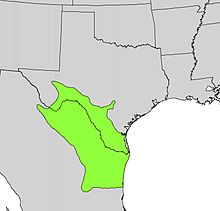Guaiacum angustifolium
| Guaiacum angustifolium | |
|---|---|
 |
|
| Scientific classification | |
| Kingdom: | Plantae |
| (unranked): | Angiosperms |
| (unranked): | Eudicots |
| (unranked): | Rosids |
| Order: | Zygophyllales |
| Family: | Zygophyllaceae |
| Genus: | Guaiacum |
| Species: | G. angustifolium |
| Binomial name | |
|
Guaiacum angustifolium Engelm. |
|
 |
|
| Natural range | |
| Synonyms | |
Porlieria angustifolia (Engelm.) A.Gray
Guaiacum angustifolium is a species of flowering plant in the caltrop family, Zygophyllaceae. Common names include Texas guaiacum, Texas lignum-vitae, soapbush and huayacán. It is native to southern and western Texas in the United States and northern Mexico. The specific name is derived from the Latin words angustus, meaning "narrow," and folius, meaning "leaf."
Texas lignum-vitae is a many branched shrub or small tree, reaching a height of 7 m (23 ft). This evergreen has a dense canopy and short lateral branches.
Leaves are 1–3 cm (0.39–1.18 in) long, opposite and pinnately compound, with four to eight pairs of leaflets. The dark green, leathery, linear to linear-spatulate leaflets are 5–16 mm (0.20–0.63 in) long and 2–3 mm (0.079–0.118 in) wide. Leaflets fold themselves at night and when exposed to hot sunlight.
The small blue to purple flowers are 12–22 mm (0.47–0.87 in) in diameter. They have five sepals, five petals around 1 cm (0.39 in) in length, and ten stamens. The blooming period lasts from March until September, with flowers appearing after rain.
The fruit is a flat, leathery capsule 1–2 cm (0.39–0.79 in) in diameter with one to two lobes, sometimes as many as four. Dehiscent locules contain a single shiny, bean-like seed that is usually bright red.
...
Wikipedia

